
Norman Percevel Rockwell was an American painter and illustrator. His works have a broad popular appeal in the United States for their reflection of the country's culture. Rockwell is most famous for the cover illustrations of everyday life he created for The Saturday Evening Post magazine over nearly five decades. Among the best-known of Rockwell's works are the Willie Gillis series, Rosie the Riveter, The Problem We All Live With, Saying Grace, and the Four Freedoms series. He is also noted for his 64-year relationship with the Boy Scouts of America (BSA), during which he produced covers for their publication Boys' Life, calendars, and other illustrations. These works include popular images that reflect the Scout Oath and Scout Law such as The Scoutmaster, A Scout Is Reverent and A Guiding Hand, among many others.
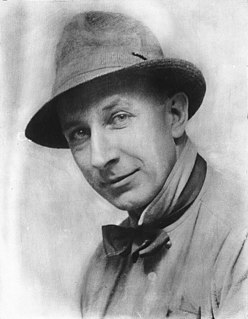
George Wesley Bellows was an American realist painter, known for his bold depictions of urban life in New York City. He became, according to the Columbus Museum of Art, "the most acclaimed American artist of his generation".

The Norman Rockwell Museum is an art museum in Stockbridge, Massachusetts, dedicated to the art of Norman Rockwell. It is home to the world's largest collection of original Rockwell art. The museum also hosts traveling exhibitions pertaining to American illustration.

American Regionalism is an American realist modern art movement that included paintings, murals, lithographs, and illustrations depicting realistic scenes of rural and small-town America primarily in the Midwest. It arose in the 1930s as a response to the Great Depression, and ended in the 1940s due to the end of World War II and a lack of development within the movement. It reached its height of popularity from 1930 to 1935, as it was widely appreciated for its reassuring images of the American heartland during the Great Depression. Despite major stylistic differences between specific artists, Regionalist art in general was in a relatively conservative and traditionalist style that appealed to popular American sensibilities, while strictly opposing the perceived domination of French art.
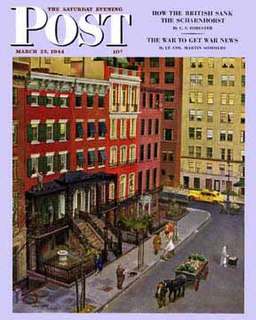
John Philip Falter was an American artist best known for his many cover paintings for The Saturday Evening Post.

Freedom from Fear is the last of the well-known Four Freedoms oil paintings produced by the American artist Norman Rockwell. The series was based on the four goals known as the Four Freedoms, which were enunciated by President Franklin D. Roosevelt in his State of the Union Address on January 6, 1941. This work was published in the March 13, 1943, issue of The Saturday Evening Post alongside an essay by a prominent thinker of the day, Stephen Vincent Benét. The painting is generally described as depicting American children being tucked into bed by their parents while the Blitz rages across the Atlantic in Great Britain.

Willie Gillis, Jr. is a fictional character created by Norman Rockwell for a series of World War II paintings that appeared on the covers of 11 issues of The Saturday Evening Post between 1941 and 1946. Gillis was an everyman with the rank of private whose career was tracked on the cover of the Post from induction through discharge without being depicted in battle. He and his girlfriend were modeled by two of Rockwell's acquaintances.

The Four Freedoms is a series of four oil paintings made in 1943 by the American artist Norman Rockwell. The paintings—Freedom of Speech, Freedom of Worship, Freedom from Want, and Freedom from Fear—are each approximately 45.75 by 35.5 inches, and are now in the Norman Rockwell Museum in Stockbridge, Massachusetts. The four freedoms refer to President Franklin D. Roosevelt's January 1941 Four Freedoms State of the Union address, in which he identified essential human rights that should be universally protected. The theme was incorporated into the Atlantic Charter, and became part of the Charter of the United Nations. The paintings were reproduced in The Saturday Evening Post over four consecutive weeks in 1943, alongside essays by prominent thinkers of the day. They became the highlight of a touring exhibition sponsored by The Post and the U.S. Department of the Treasury. The exhibition and accompanying sales drives of war bonds raised over $132 million.

Freedom of Speech is the first of the Four Freedoms paintings by Norman Rockwell, inspired by United States President Franklin D. Roosevelt's 1941 State of the Union address, known as Four Freedoms.

Freedom of Worship or Freedom to Worship is the second of the Four Freedoms oil paintings produced by the American artist Norman Rockwell. The series was based on the goals known as the Four Freedoms enunciated by Franklin D. Roosevelt, president of the United States from 1933 to 1945, in his State of the Union Address delivered on January 6, 1941. Rockwell considered this painting and Freedom of Speech the most successful of the series. Freedom of Worship was published in the February 27, 1943, issue of The Saturday Evening Post alongside an essay by philosopher Will Durant.

Freedom from Want, also known as The Thanksgiving Picture or I'll Be Home for Christmas, is the third of the Four Freedoms series of four oil paintings by American artist Norman Rockwell. The works were inspired by United States President Franklin D. Roosevelt's 1941 State of the Union Address, known as Four Freedoms.

The Problem We All Live With is a painting by Norman Rockwell that was considered an iconic image of the Civil Rights Movement in the United States. It depicts Ruby Bridges, a six-year-old African-American girl, on her way to William Frantz Elementary School, an all-white public school, on November 14, 1960, during the New Orleans school desegregation crisis. Because of threats of violence against her, she is escorted by four deputy U.S. marshals; the painting is framed so that the marshals' heads are cropped at the shoulders. On the wall behind her are written the racial slur "nigger" and the letters "KKK"; a smashed and splattered tomato thrown against the wall is also visible. The white protesters are not visible, as the viewer is looking at the scene from their point of view. The painting is oil on canvas and measures 36 inches (91 cm) high by 58 inches (150 cm) wide.

Red Kimono on the Roof is an oil painting by American artist John Sloan, located in the Indianapolis Museum of Art, which is in Indianapolis, Indiana, USA. Painted in 1912, its down-to-earth subject matter and execution make it an excellent example of the work of the Ashcan School, which was active in New York City in the early years of the twentieth century.
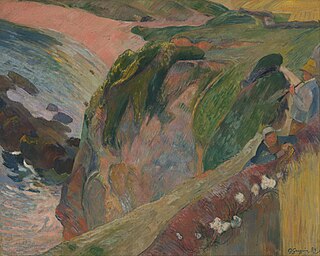
The Flageolet Player on the Cliff is an 1889 oil painting by French artist Paul Gauguin, located in the Indianapolis Museum of Art, which is in Indianapolis, Indiana. It depicts a Breton couple on a narrow path precipitously overlooking the Atlantic.

Landscape near Arles is an 1888 oil painting by French artist Paul Gauguin depicting a rural scene in Provence. It is currently located in the Indianapolis Museum of Art in Indianapolis, Indiana.

Tom Lovell was an American illustrator and painter. He was a creator of pulp fiction magazine covers and illustrations, and of visual art of the American West. He produced illustrations for National Geographic magazine and many others, and painted many historical Western subjects such as interactions between Indians and white settlers and traders. He was inducted into the Society of Illustrators' Hall of Fame in 1974.

Untitled is a 1938 tempera painting by American artist Jacob Lawrence, located in the Indianapolis Museum of Art, which is in Indianapolis, Indiana. Depicting a scene of childbirth in flat, geometric forms and bright colors, it is very much a product of the Harlem Renaissance.
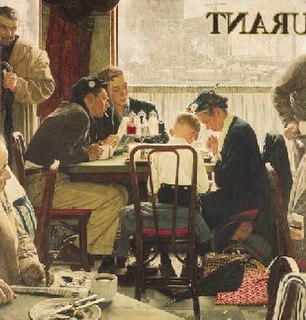
Saying Grace is a 1951 painting by American illustrator Norman Rockwell, painted for the cover of The Saturday Evening Post's November 24, 1951, Thanksgiving issue.
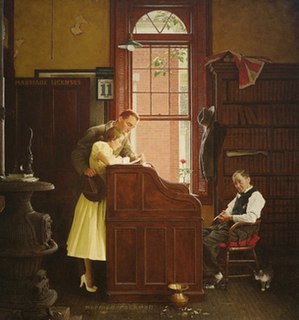
Marriage License is a painting by American illustrator Norman Rockwell. It was originally created for the cover of the June 11, 1955, edition of The Saturday Evening Post. It depicts a young man and woman filling out a marriage license application at city hall in front of a bored-looking clerk. The painting was based off of reference photos taken of Stockbridge native Joan Lahart, her fiancée Francis Mahoney, a retired NBA player, and local shopkeeper Jason Braman. Since appearing on the cover of The Saturday Evening Post, the painting has been praised by critics and is considered one of Rockwell's best works.


















